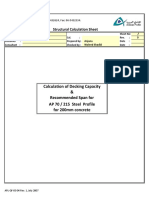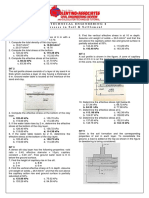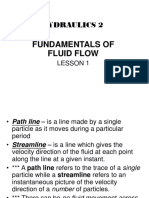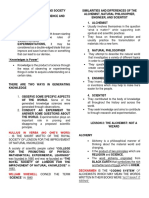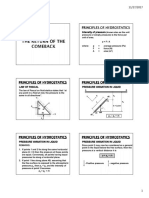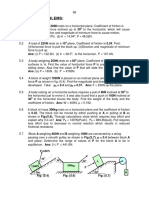Module-1-FLUID PROPERTIES
Uploaded by
Ferry CaballasModule-1-FLUID PROPERTIES
Uploaded by
Ferry CaballasUnit FLUID PROPERTIES
Module 1 – Fluid Properties
Learning After finishing this module, you are expected to:
Objectives
1. Define system, boundary, surroundings, state,
process, and property.
2. Define density, specific gravity, and specific weight.
3. Relate these properties using calculations.
4. Explain the meaning of a constant density fl ow and
discuss the relevant issues.
5. Look up fluid properties; document the results.
6. Define viscosity, shear stress, shear force, velocity
gradient, velocity profile, the no-slip condition, and
kinematic viscosity.
7. Describe surface tension; solve relevant problems.
Topics 1.1 Introduction
1.2 Mass Density
1.3 Specific Weight/Unit Weight
1.4 Specific Volume
1.5 Specific Gravity
1.6 Bulk Modulus
1.7 Viscosity
1.8 Kinematic Viscosity
1.9 Surface Tension
1.10 Capillary
Engineering Fluid Mechanics 9th Edition, Crowe C., Elger D., Williams B., Roberson J.
Fluid Mechanics and Hydraulics, Dit Gillesania
Hydraulics, Besavilla
1.1 Introduction
Mechanics is the field of science focused on the motion of material bodies. Mechanics
involves force, energy, motion, deformation, and material properties. When mechanics applies to
material bodies in the solid phase, the discipline is called solid mechanics. When the material
body is in the gas or liquid phase, the discipline is called fluid mechanics. In contrast to a solid, a
fluid is a substance whose molecules move freely past each other. More specifically, a fluid is a
substance that will continuously deform—that is, flow under the action of a shear stress.
Alternatively, a solid will deform under the action of a shear stress but will not flow like a fluid.
Both liquids and gases are classified as fluids.
Engr. Christian Karl B. Villaluz| Camarines Sur Polytechnic Colleges 1
Unit FLUID PROPERTIES
1
PROPERTIES OF FLUID
1.2 Mass Density
Mass Density is defined as the ratio of mass to volume at a point, given by.
𝒎
𝝆=
𝑽
Where:
𝝆=mass density units (English slugs/ft3, SI kg/m3)
m=mass, kg or slugs
V=Volume, m3 or ft3
For ideal gas, its density can be found from the specific gas constant and ideal gas law:
𝒑
𝝆=
𝑹𝑻
Where:
𝝆=mass density units (English slugs/ft3, SI kg/m3)
p=absolute pressure of gas in Pa
R=gas constant Joule/kg.°K
T=absolute temperature, K
1.3 Specific Weight/Unit Weight, 𝜸
The gravitational force per unit volume of fluid, or simply the weight per unit volume, is
defined as specific weight.
𝛾 = 𝜌𝑔
Engr. Christian Karl B. Villaluz| Camarines Sur Polytechnic Colleges 2
Unit FLUID PROPERTIES
1
1.4 Specific Volume
𝟏
𝑺𝒑𝒆𝒄𝒊𝒇𝒊𝒄 𝑽𝒐𝒍𝒖𝒎𝒆 =
𝝆
1.5 Specific Gravity
The ratio of the specific weight of a given fluid to the specific weight of water at the standard
reference temperature 4°C is defined as specific gravity, S:
𝛾𝑓𝑙𝑢𝑖𝑑
𝑺𝑮 =
𝛾𝑤𝑎𝑡𝑒𝑟
Specific Weight of Water @ 20°C = 9.79kN/m3
Specific Weight of Water @ 4°C = 9.81kN/m3
EXAMPLE: CE BOARD NOV. 1995
If 5.6m3 of oil weighs 46,000 N, calculate the following:
a. Unit Weight
b. Density
c. Specific Gravity
EXAMPLE:
A certain liquid has a unit weight of 55 kN/m3.
a. Compute the mass density.
b. Calculate its specific volume.
c. Compute its specific gravity.
Engr. Christian Karl B. Villaluz| Camarines Sur Polytechnic Colleges 3
Unit FLUID PROPERTIES
1
EXAMPLE:
A gas having a volume of 40 liters has a pressure of 0.25MPa at 24C. If the gas constant
R is equal to 210 MN/kg.k. Compute:
a. Density of the gas
b. Mass of the gas
c. Weight of gas
1.6 Bulk Modulus
−∆𝑷
𝑬=
∆𝑽
𝑽
Where:
E=bulk modulus
∆P=change in pressure
∆V=change in volume
COEFFICIENT O COMPRESSIBILITY
𝟏
𝜷=
𝑬
Where:
E=bulk modulus
𝜷=Coefficient of compressibility
Engr. Christian Karl B. Villaluz| Camarines Sur Polytechnic Colleges 4
Unit FLUID PROPERTIES
1
EXAMPLE:
A liquid which is compressed in a cylinder . If it has a volume of 1000cu.cm.(1 liter)
at 2 MPa and a volume of 990 cu.cm. at 2.6MPa.
a. Compute the bulk modulus of elasticity.
b. Compute the percentage of volume decreased.
c. Compute the coefficient of compressibility.
1.7 Viscosity, 𝝁
(also called dynamic viscosity, or absolute viscosity) is a measure of a fluid’s resistance
to deformation under shear stress.
Engr. Christian Karl B. Villaluz| Camarines Sur Polytechnic Colleges 5
Unit FLUID PROPERTIES
1
𝝉
𝝁=
𝒅𝑽/𝒅𝒚
Where:
𝜏=shear stress in lb/ft2 or Pa
𝜇=absolute viscosity in lb sec/ft2 (poises) or Pa-sec
y=distance between the plates in ft or m.
V=velocity in ft/s or m/s
1.8 Kinematic Viscosity, 𝝂
Kinematic Viscosity is the ratio of the dynamic viscosity 𝜇 of fluid, to its mass density 𝜌.
𝝁
𝝂=
𝝆
Where:
𝜇= absolute viscosity
𝜌 =density in kg/m3
EXAMPLE:
If the viscosity of water at 70°C is 0.00402 poise and its specific gravity is 0.978
determine its absolute viscosity in Pa-s and its kinematic viscosity in m2/s and in stokes.
1.9 Surface Tension, 𝝈
Surface Tension is a material property whereby a liquid at a material interface, usually
liquid-gas, exerts a force per unit length along the surface. According to the theory of
molecular attraction, molecules of liquid considerably below the surface act on each other
by forces that are equal in all directions.
Pressure inside a droplet of liquid
𝟒𝝈
𝒑=
𝒅
Where:
𝜎= surface tension in N/m
d=diameter of the droplet in meter
p=gage pressure in Pascals
Engr. Christian Karl B. Villaluz| Camarines Sur Polytechnic Colleges 6
Unit FLUID PROPERTIES
1
1.10 Capillary
Capillary (Capillary action) is the name given to the behavior of the liquid in a thin-bore
tube. The rise or fall of a fluid in a capillary tube is caused by surface tension and
depends on the relative magnitudes of the cohesion of the liquid and the adhesion of the
liquid to the walls of the containing vessel.
𝟒𝝈𝒄𝒐𝒔𝜽
𝒉=
𝜸𝒅
For complete wetting, as with water on clean glass, the angle is 0.
Hence the formula becomes
𝟒𝝈
𝒉=
𝜸𝒅
Where:
h=capillary rise or depression in m
𝜎= surface tension in Pa
d=diameter of the droplet in meter
𝜸=gage pressure in Pascals
EXAMPLE:
Determine the surface tension of water in a tube with 0.2m radius and wetting
angle 0° and capillary rise of 5mm. Determine the surface tension in lb/ft. If wetting angle
θ=80°, determine the surface tension.
Engr. Christian Karl B. Villaluz| Camarines Sur Polytechnic Colleges 7
You might also like
- Hourglass Workout Program by Luisagiuliet 276% (21)Hourglass Workout Program by Luisagiuliet 251 pages
- The Hold Me Tight Workbook - Dr. Sue Johnson100% (16)The Hold Me Tight Workbook - Dr. Sue Johnson187 pages
- Read People Like A Book by Patrick King-Edited62% (66)Read People Like A Book by Patrick King-Edited12 pages
- Livingood, Blake - Livingood Daily Your 21-Day Guide To Experience Real Health77% (13)Livingood, Blake - Livingood Daily Your 21-Day Guide To Experience Real Health260 pages
- COSMIC CONSCIOUSNESS OF HUMANITY - PROBLEMS OF NEW COSMOGONY (V.P.Kaznacheev,. Л. V. Trofimov.)94% (212)COSMIC CONSCIOUSNESS OF HUMANITY - PROBLEMS OF NEW COSMOGONY (V.P.Kaznacheev,. Л. V. Trofimov.)212 pages
- Donald Trump & Jeffrey Epstein Rape Lawsuit and Affidavits83% (1016)Donald Trump & Jeffrey Epstein Rape Lawsuit and Affidavits13 pages
- The 36 Questions That Lead To Love - The New York Times94% (34)The 36 Questions That Lead To Love - The New York Times3 pages
- The 36 Questions That Lead To Love - The New York Times95% (21)The 36 Questions That Lead To Love - The New York Times3 pages
- Jeffrey Epstein39s Little Black Book Unredacted PDF75% (12)Jeffrey Epstein39s Little Black Book Unredacted PDF95 pages
- The 4 Hour Workweek, Expanded and Updated by Timothy Ferriss - Excerpt23% (954)The 4 Hour Workweek, Expanded and Updated by Timothy Ferriss - Excerpt38 pages
- Engineering Mechanics Competency Exam Set B Students 20181No ratings yetEngineering Mechanics Competency Exam Set B Students 201811 page
- RCD Module 1 INTRO TO FUNDAMENTALS OF REINFORCED CONCRETE DESIGNNo ratings yetRCD Module 1 INTRO TO FUNDAMENTALS OF REINFORCED CONCRETE DESIGN20 pages
- Highway and Railroad Engineering Part 1&2No ratings yetHighway and Railroad Engineering Part 1&27 pages
- Fundamentals of Surveying - Horizontal DistanceNo ratings yetFundamentals of Surveying - Horizontal Distance11 pages
- Determination of Coefficient of Discharge of A Submerged OrificeNo ratings yetDetermination of Coefficient of Discharge of A Submerged Orifice1 page
- Introduction To Soil Mechanics and FoundationsNo ratings yetIntroduction To Soil Mechanics and Foundations64 pages
- Module 6 Discharge Energy and Head Power and Efficiency Bernoullis Energy TheoremNo ratings yetModule 6 Discharge Energy and Head Power and Efficiency Bernoullis Energy Theorem16 pages
- Numerical Problems Related To Phase RelationshipNo ratings yetNumerical Problems Related To Phase Relationship1 page
- Week 5 Module - Surveying, Transportation Engineering, Highway Engineering, Ports and HarborNo ratings yetWeek 5 Module - Surveying, Transportation Engineering, Highway Engineering, Ports and Harbor5 pages
- Blueprint of A Philippine Nation in The 21st Century (Modification)No ratings yetBlueprint of A Philippine Nation in The 21st Century (Modification)3 pages
- Lesson 5 - Resistance To Movement in The WaterNo ratings yetLesson 5 - Resistance To Movement in The Water8 pages
- Hydraulics 2: Fundamentals of Fluid FlowNo ratings yetHydraulics 2: Fundamentals of Fluid Flow37 pages
- 4.) RCD - Midterm Library Work Quiz - Concept and Solutions (1-Way Slab)100% (1)4.) RCD - Midterm Library Work Quiz - Concept and Solutions (1-Way Slab)8 pages
- Question: A 20-kg Package Is at Rest On An Incline When A Force P Is AppliNo ratings yetQuestion: A 20-kg Package Is at Rest On An Incline When A Force P Is Appli2 pages
- Wind Loads On Buildings-Mwfrs (Envelope Procedure) : User Note: Use Part 1 of Chapter 28 To Determine TheNo ratings yetWind Loads On Buildings-Mwfrs (Envelope Procedure) : User Note: Use Part 1 of Chapter 28 To Determine The10 pages
- CE 151 - Geotechnical Engineering 1 Soil ClassificationNo ratings yetCE 151 - Geotechnical Engineering 1 Soil Classification8 pages
- 3 CE131P - Analysis of Statically Determinate Structures v2 (Robles)No ratings yet3 CE131P - Analysis of Statically Determinate Structures v2 (Robles)23 pages
- Mathematics Quiz 19 Solutions 18 Oct. 2021 PDFNo ratings yetMathematics Quiz 19 Solutions 18 Oct. 2021 PDF12 pages
- CE 73B-Timber Design 1. Title of The Module: Floor Framing and Notching/DappingNo ratings yetCE 73B-Timber Design 1. Title of The Module: Floor Framing and Notching/Dapping23 pages
- Student Outcomes (Sos) Addressed by The Activity: Mechanics of Fluid Laboratory ManualNo ratings yetStudent Outcomes (Sos) Addressed by The Activity: Mechanics of Fluid Laboratory Manual10 pages
- Fluid Mech Lecture Part 2 Principles of HydrostaticsNo ratings yetFluid Mech Lecture Part 2 Principles of Hydrostatics7 pages
- 4 SOLVING SYSTEM OF LINEAR EQUATIONS Part 1No ratings yet4 SOLVING SYSTEM OF LINEAR EQUATIONS Part 160 pages
- 2 Fundamentals of Computer Aided Mathematical CalculationsNo ratings yet2 Fundamentals of Computer Aided Mathematical Calculations41 pages
- 1 Review of The Mathematical FoundationNo ratings yet1 Review of The Mathematical Foundation29 pages
- Semistor - VI Physics Paper IV Theory of Relativity-1No ratings yetSemistor - VI Physics Paper IV Theory of Relativity-19 pages
- Theory of Plates & Shells: M.Tech - Second Semester (Civil Engineering (Structural Engineering) ) (Old) Full-TimeNo ratings yetTheory of Plates & Shells: M.Tech - Second Semester (Civil Engineering (Structural Engineering) ) (Old) Full-Time2 pages
- Radioss Theory Manual: 12.0 Version - Nov 2012 Large Displacement Finite Element AnalysisNo ratings yetRadioss Theory Manual: 12.0 Version - Nov 2012 Large Displacement Finite Element Analysis52 pages
- 9702 Thermal Properties All Completed Upto May June 2011No ratings yet9702 Thermal Properties All Completed Upto May June 20110 pages
- 6 Mechanical Waves Examples in Real LifeNo ratings yet6 Mechanical Waves Examples in Real Life6 pages
- Samar State University Midterm Exams in PhysicsNo ratings yetSamar State University Midterm Exams in Physics3 pages
- Chapter: Mechanical - Kinematics of Machinery - Kinematics of Cam Mechanisms CamsNo ratings yetChapter: Mechanical - Kinematics of Machinery - Kinematics of Cam Mechanisms Cams25 pages
- Response of Footing On Sand Slopes: Indian Geotechnical Society Chennai ChapterNo ratings yetResponse of Footing On Sand Slopes: Indian Geotechnical Society Chennai Chapter4 pages
- Livingood, Blake - Livingood Daily Your 21-Day Guide To Experience Real HealthLivingood, Blake - Livingood Daily Your 21-Day Guide To Experience Real Health
- COSMIC CONSCIOUSNESS OF HUMANITY - PROBLEMS OF NEW COSMOGONY (V.P.Kaznacheev,. Л. V. Trofimov.)COSMIC CONSCIOUSNESS OF HUMANITY - PROBLEMS OF NEW COSMOGONY (V.P.Kaznacheev,. Л. V. Trofimov.)
- Donald Trump & Jeffrey Epstein Rape Lawsuit and AffidavitsDonald Trump & Jeffrey Epstein Rape Lawsuit and Affidavits
- The 36 Questions That Lead To Love - The New York TimesThe 36 Questions That Lead To Love - The New York Times
- The 36 Questions That Lead To Love - The New York TimesThe 36 Questions That Lead To Love - The New York Times
- Jeffrey Epstein39s Little Black Book Unredacted PDFJeffrey Epstein39s Little Black Book Unredacted PDF
- The 4 Hour Workweek, Expanded and Updated by Timothy Ferriss - ExcerptThe 4 Hour Workweek, Expanded and Updated by Timothy Ferriss - Excerpt
- Engineering Mechanics Competency Exam Set B Students 20181Engineering Mechanics Competency Exam Set B Students 20181
- RCD Module 1 INTRO TO FUNDAMENTALS OF REINFORCED CONCRETE DESIGNRCD Module 1 INTRO TO FUNDAMENTALS OF REINFORCED CONCRETE DESIGN
- Determination of Coefficient of Discharge of A Submerged OrificeDetermination of Coefficient of Discharge of A Submerged Orifice
- Module 6 Discharge Energy and Head Power and Efficiency Bernoullis Energy TheoremModule 6 Discharge Energy and Head Power and Efficiency Bernoullis Energy Theorem
- Week 5 Module - Surveying, Transportation Engineering, Highway Engineering, Ports and HarborWeek 5 Module - Surveying, Transportation Engineering, Highway Engineering, Ports and Harbor
- Blueprint of A Philippine Nation in The 21st Century (Modification)Blueprint of A Philippine Nation in The 21st Century (Modification)
- 4.) RCD - Midterm Library Work Quiz - Concept and Solutions (1-Way Slab)4.) RCD - Midterm Library Work Quiz - Concept and Solutions (1-Way Slab)
- Question: A 20-kg Package Is at Rest On An Incline When A Force P Is AppliQuestion: A 20-kg Package Is at Rest On An Incline When A Force P Is Appli
- Wind Loads On Buildings-Mwfrs (Envelope Procedure) : User Note: Use Part 1 of Chapter 28 To Determine TheWind Loads On Buildings-Mwfrs (Envelope Procedure) : User Note: Use Part 1 of Chapter 28 To Determine The
- CE 151 - Geotechnical Engineering 1 Soil ClassificationCE 151 - Geotechnical Engineering 1 Soil Classification
- 3 CE131P - Analysis of Statically Determinate Structures v2 (Robles)3 CE131P - Analysis of Statically Determinate Structures v2 (Robles)
- CE 73B-Timber Design 1. Title of The Module: Floor Framing and Notching/DappingCE 73B-Timber Design 1. Title of The Module: Floor Framing and Notching/Dapping
- Student Outcomes (Sos) Addressed by The Activity: Mechanics of Fluid Laboratory ManualStudent Outcomes (Sos) Addressed by The Activity: Mechanics of Fluid Laboratory Manual
- Fluid Mech Lecture Part 2 Principles of HydrostaticsFluid Mech Lecture Part 2 Principles of Hydrostatics
- 2 Fundamentals of Computer Aided Mathematical Calculations2 Fundamentals of Computer Aided Mathematical Calculations
- Semistor - VI Physics Paper IV Theory of Relativity-1Semistor - VI Physics Paper IV Theory of Relativity-1
- Theory of Plates & Shells: M.Tech - Second Semester (Civil Engineering (Structural Engineering) ) (Old) Full-TimeTheory of Plates & Shells: M.Tech - Second Semester (Civil Engineering (Structural Engineering) ) (Old) Full-Time
- Radioss Theory Manual: 12.0 Version - Nov 2012 Large Displacement Finite Element AnalysisRadioss Theory Manual: 12.0 Version - Nov 2012 Large Displacement Finite Element Analysis
- 9702 Thermal Properties All Completed Upto May June 20119702 Thermal Properties All Completed Upto May June 2011
- Chapter: Mechanical - Kinematics of Machinery - Kinematics of Cam Mechanisms CamsChapter: Mechanical - Kinematics of Machinery - Kinematics of Cam Mechanisms Cams
- Response of Footing On Sand Slopes: Indian Geotechnical Society Chennai ChapterResponse of Footing On Sand Slopes: Indian Geotechnical Society Chennai Chapter
































